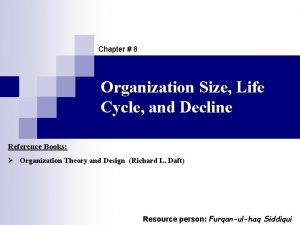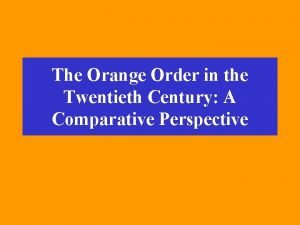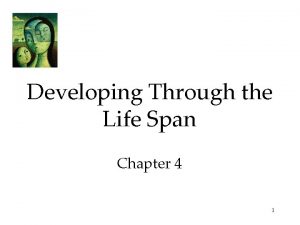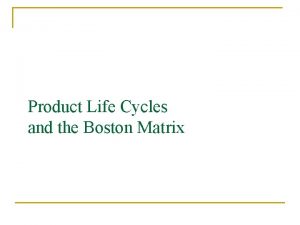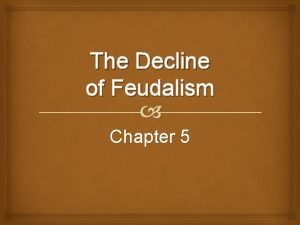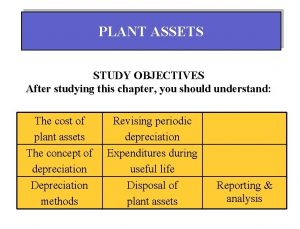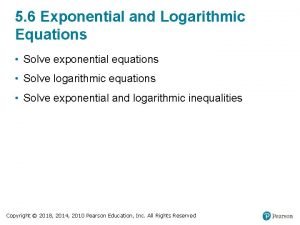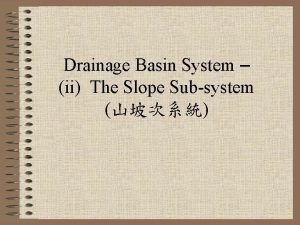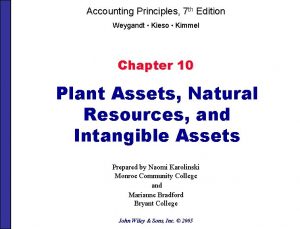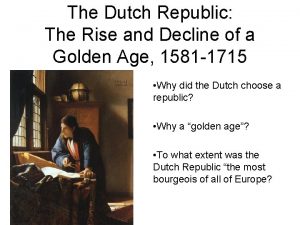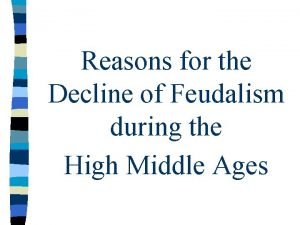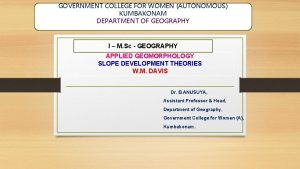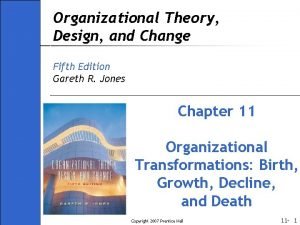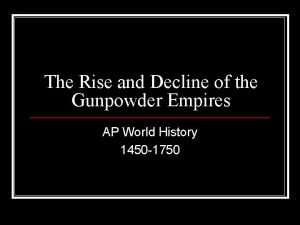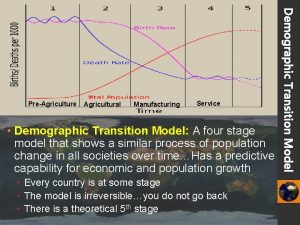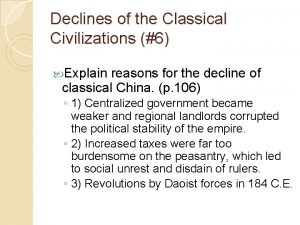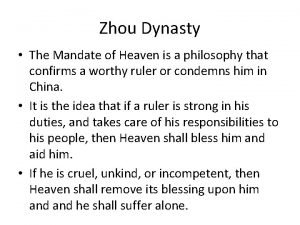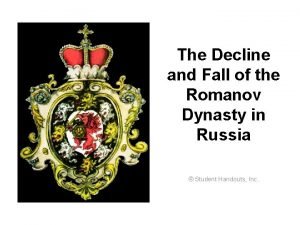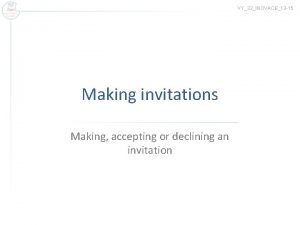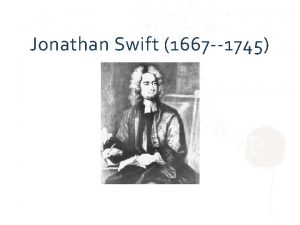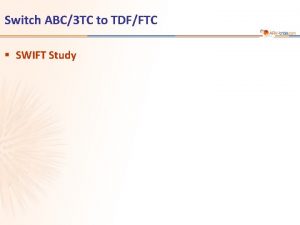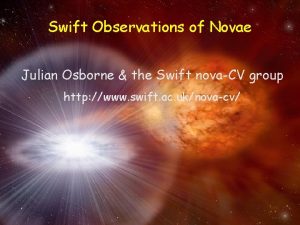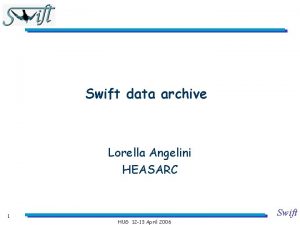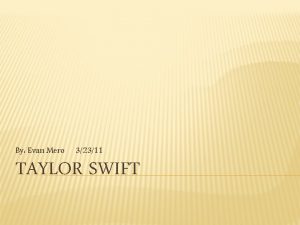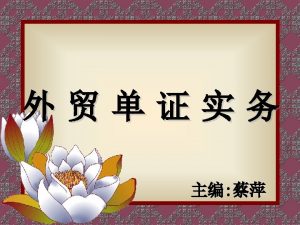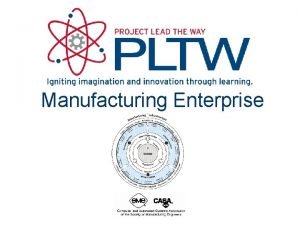The Surprisingly Swift Decline of U S Manufacturing













































- Slides: 45

The Surprisingly Swift Decline of U. S. Manufacturing Employment Justin R. Pierce Board of Governors of the Federal Reserve System Peter K. Schott Yale School of Management & NBER

Disclaimer Any opinions and conclusions expressed herein are those of the authors and do not necessarily represent the views of the U. S. Census Bureau, the Board of Governors or its research staff. All results have been reviewed to ensure that no confidential information is disclosed. 2

Post-War U. S. Manufacturing Employment 3

Post-War U. S. Manufacturing Employment 4

Post-War U. S. Manufacturing Employment -2. 9 mill over 3 years 5

Post-War U. S. Manufacturing Employment -2. 9 mill over 3 years 6

Introduction • We link the post-2001 decline in US manufacturing employment to China’s receipt of Permanent Normal Trade Relations (PNTR) • PNTR did not change actual tariff rates – Chinese imports were eligible for low NTR rates starting in 1980 – But access to these rates required annual renewal by Congress – Without renewal, tariffs would rise to higher, Smoot-Hawley levels • With PNTR, the possibility of tariff hikes was eliminated • Pre-PNTR uncertainty over possible tariff hikes likely discouraged – US firms from investing in trade relationships with Chinese firms – US firms from openings plants in China – U. S. firms from investing in labor-saving technologies – Chinese firms from making investments to export to US 7

Before Continuing… Despite the sharp decline in employment after 2001, real value added continues rising at its historical pace 8

Outline • US-China Trade Policy • Census Data • Main results • Mechanisms • Conclusion 9

US NTR and Non-NTR Tariffs • NTR = Normal Trade Relations – Synonym for Most Favored Nation (MFN) • The US has two basic tariff schedules – NTR tariffs : for WTO members; generally low – Non-NTR tariffs : for non-market economies; generally high; set by Smoot-Hawley (1930) • How does China fit into these categories? 10

US-China Trade Policy, 1980 -2001 (December) China enters WTO Annual renewals of MFN status were uncertain 1980 (February) China was granted temporary NTR status by the US Congress Temporary NTR requires annual re-approval by Congress 2000 (October) U. S. Congress grants China PNTR, eliminating the risk that a failed vote might lead to a jump in tariffs 11

Plausible Mechanism? “U. S. companies expect to benefit from billions of dollars in new business and an end to years of uncertainty in which they had put off major decisions about investing in China. NYT 2000. 9. 20 “[P]rivate sector officials cited uncertainty surrounding the annual renewal of China’s most-favored-nation trade status as the single most important issue affecting U. S. trade relations with China…. [T]he great majority of the U. S. business associations and companies… contacted told us that the annual uncertainty surrounding China’s MFN status potentially hinders their business activities in China. ” US GAO 1994. 5. 4 “While the risk that the United States would withdraw NTR status from China may be small, if it did occur the consequences would be catastrophic for U. S. toy companies given the 70 percent non-MFN U. S. rate of duty applicable to toys. ” Testimony of Thomas F. St. Maxens (Mattel) Ways and Means Committee 2000. 2. 16 “In the months since the enactment of [PNTR] there has been an escalation of production shifts out of the U. S. and into China. According to our media-tracking data, between October 1, 2000 and April 30, 2001 more than eighty corporations announced their intentions to shift production to China, with the number of announced production shifts increasing each month from two per month in October to November to nineteen per month by April. ” Bronfenbrenner et al. (2001. 6. 30) U. S. -China Security Review Commission

The “NTR Gap” i=industry • Define the difference between the non-NTR and NTR rates as NTR Gapi = Non-NTR Tariffi – NTR Tariffi • Calculated using tariff-line (HS 8) data from Feenstra et al. (2003) – Use tariffs for 1999, the year before PNTR – Gap for industry i is the mean across tariff lines in industry i 13

Distribution of NTR Gap Mean: 0. 32 Std: 0. 15 • 89 percent of the variation in the NTR gap across industries arises from variation in non-NTR rates, which were set in 1930 • The higher the NTR gap, the greater the industry’s exposure to potential tariff increases before PNTR 14

Preview of Results • Divide U. S. manufacturing industries or import products into two groups based on whether their NTR gap is above or below the median • Plot their trajectory before and after PNTR 15

Preview of Findings – Employment Public NBER-CES Data • Before PNTR: high- and low-gap industries follow roughly parallel trends • Post PNTR: employment falls more sharply among high-gap industries • Note: we use the gap as a continuous variable in our regression analysis. 16

Preview of Findings – Trade Public Census Trade Data • Imports from China in the moreexposed products jump after PNTR 17

Preview of Findings – Trade Public Census Trade Data China ROW • Imports from China in the moreexposed products jump after PNTR • This trend is not present in imports from rest-of-world (ROW) 18

Preview of Findings – Trade Public Census Trade Data China ROW • Imports from China in the moreexposed products jump after PNTR • This trend is not present in imports from rest-of-world (ROW) • Below, we use census data to examine margins of adjustment • New US importers • New Chinese Exporters • New Importer-exporter pairs 19

Related Research • Employment and trade liberalization – Lots of papers – China: Autor et al. (2013); Bloom et al. (2015) • Investment under uncertainty – Lots of papers – Trade: Handley (2014); Handley and Limao (2014 a, 2014 b) • “Jobless” recoveries – Manufacturing: Faberman (2012) • Supply-chain linkages – US manufacturing: Ellison, Glaeser and Kerr (2010) – Trade: Baldwin and Venables (2013) 20

Outline • US-China Trade Policy • Census Data • Main results • Mechanisms • Conclusion 21

Census Data • LBD – – – • Longitudinal Business Database – Employment of all U. S. establishments – Annual data but limited information – Concordance issue • CM – • Census of Manufactures – Employment + other attributes for all manufacturing establishments, 1992(5)2007 – Lots of information but low frequency – • LFTTD • Transaction-level US import data – Value – U. S. importer and foreign exporter ID’s 22

Outline • US-China Trade Policy • Data • Main results • Mechanisms • Conclusion 23

Empirical Strategy i=industry; t=year • DID specification – Regress industry-year employment from 1990 -2007 on interaction of NTR Gap and indicator for post-PNTR period (year>2000) – Add covariates that account for • Industry characteristics • Other policy changes (MFA, China’s entry into WTO, etc. ) 24

Empirical Strategy i=industry; t=year • DID specification – Regress industry-year employment from 1990 -2007 on interaction of NTR Gap and indicator for post-PNTR period (year>2000) – Add covariates that account for • Industry characteristics • Other policy changes (MFA, China’s entry into WTO, etc. ) Industry and year FE. Time-Invariant Initial K/L, Changes in Chinese import tariffs, etc. Time-Varying E. g. , MFA, NTR rate, etc. 25

Baseline Results (LBD) 26

Baseline Results (LBD) Industries with higher NTR gaps experience larger employment declines following PNTR 27

Baseline Results (LBD) Industries with higher NTR gaps experience larger employment declines following PNTR Economic significance: for each industry, compute the implied effect of PNTR (vs the pre-period) relative to a hypothetical industry with a zero NTR gap 28

Baseline Results (LBD) Not much action in terms of the other covariates, except for MFA 29

Timing (LBD) • The NTR gap should be correlated with employment after PNTR but not before 30

Timing (LBD) • The NTR gap should be correlated with employment after PNTR but not before 31

Linearity (LBD) • There is some support for the idea that employment loss accelerates with the NTR gap • The implied impacts from these specifications, however, are similar to those in the baseline specification 32

US vs EU (UNIDO) i=industry, t=year, c=country • In contrast to the United States, the EU granted permanent mostfavored-nation status to China in 1980 • We compare employment in the two regions via a triple DID 33

US vs EU (UNIDO) i=industry, t=year, c=country • In contrast to the United States, the EU granted permanent mostfavored-nation status to China in 1980 • We compare employment in the two regions via a triple DID 34

US vs EU (UNIDO) i=industry, t=year, c=country • In contrast to the United States, the EU granted permanent mostfavored-nation status to China in 1980 • We compare employment in the two regions via a triple DID Notes: Each column displays the results of an industry-level OLS generalized difference-indifferences regression of the log employment on industry (i) and year (t) fixed effects and covariates discussed in text. Data span 1998 and 2005. Interactions required to identify the triple difference-in-differences term are suppressed. Robust standard errors adjusted for clustering at the industry level are displayed below each coefficient. Observations are weighted by initial employment. Superscripts ***, ** and * represent statistical significance at the 1, 5 and 10 percent levels. 35

Outline • US-China Trade Policy • Data • Main result • Mechanisms • Conclusion 36

Mechanisms • U. S. Imports • Chinese Exports • U. S. factor intensity • Input-Output Linkages 37

U. S. Imports (LFTTD) h=product, c=country, t=year • Compare products with varying NTR gaps (first difference) before and after PNTR (second difference) and across source countries (third difference) for the years 1992 to 2007 where Ohct represents one of – Import value Interactions needed to – Number of U. S. importers identify q – Number of Chinese exporters – Number of importer-exporter pairs Time-Varying Exchange rate and NTR rate Fixed Effects 38

U. S. Imports (LFTTD) h=product, c=country, t=year • Compare products with varying NTR gaps (first difference) before and after PNTR (second difference) and across source countries (third difference) for the years 1992 to 2007 39

Chinese Exports (NBS) h=product, c=country, t=year • Similar to U. S. imports but using Chinese transaction-level trade data from the China National Bureau of Statistics (NBS) • Chinese data track export value by product • Can also see export and ownership types – Export: general versus “processing & assembly” – Ownership: SOE, Private domestic, Private foreign 40

Chinese Exports (NBS) h=product, c=country, t=year Notes: Table reports results of product-country-year level generalized triple difference-in-differences OLS regressions of log Chinese export value on noted triple difference-in-differece term as well as product (h), country (c) and year (t) fixed effects. Results for fixed effects as well as all other terms required to identify the triple difference-in-differences term of interest are suppressed. Data span 2000 to 2005. Robust standard errors adjusted for clustering at the product level are displayed below each coefficient. All exports are defined as the sum of general and processing & assembly (P&A) exports. All firms are the union of state-owned enterprises, privately owned domestic firms and privately owned foreign firms. Superscripts ***, ** and * represent statistical significance at the 1, 5 and 10 percent levels. 41

Changes in U. S. Factor Intensity • Comparison of plant employment and plant death regressions reveal that some plants were able to adapt to the change in U. S. policy rather than die • PNTR is associated with increased capital intensity at both the industry and plant level that are consistent with – Changes in product composition (Khandelwal 2010) – Adoption of labor-saving technologies (Bloom, Draca and Van Reenen 2015) • Latter suggests PNTR may be associated with employment reductions beyond those attributable to replacement of U. S. production by Chinese imports 42

Input-Output Linkages • Use input output tables to compute plant’s exposure to PNTR via upstream and downstream NTR gaps • Employment among continuing plants and plant survival respond negatively to exposure to PNTR in downstream (customer) industries, providing indirect evidence of trade-induced supply-chain disruptions (Baldwin and Venables 2013) 43

Conclusions • Strong link between US manufacturing job loss and PNTR – Not evident in EU which did not undergo similar policy change • Potential mechanisms include – Greater incentives for U. S. firms to import inputs and final goods – Greater incentives for Chinese firms to scale up exports – Greater incentives for U. S. firms to introduce labor-saving technologies • Next steps – Did PNTR induce reallocation within firms? – How did PNTR affect procurement patterns? 44

Thanks! 45
 Manufacturing cost vs non manufacturing cost
Manufacturing cost vs non manufacturing cost Manufacturing cost vs non manufacturing cost
Manufacturing cost vs non manufacturing cost Additively
Additively Manufacturing cost vs non manufacturing cost
Manufacturing cost vs non manufacturing cost Controllable expenses examples
Controllable expenses examples Chegg
Chegg Peak stage of fashion cycle
Peak stage of fashion cycle Chapter 26 lesson 1 the decline of the qing dynasty
Chapter 26 lesson 1 the decline of the qing dynasty Orange order decline
Orange order decline Sensory decline
Sensory decline What factors led to the decline of the roman republic
What factors led to the decline of the roman republic Sensory decline
Sensory decline Russia 1450
Russia 1450 Boston matrix and product life cycle
Boston matrix and product life cycle The decline of feudalism chapter 5 answer key
The decline of feudalism chapter 5 answer key Double declining formula
Double declining formula Glory war and decline
Glory war and decline Ille illa illud chart
Ille illa illud chart Logarithmic decline
Logarithmic decline The difference between slope decline and slope retreat
The difference between slope decline and slope retreat Double decline balance method formula
Double decline balance method formula Fertility rate
Fertility rate Why did the dutch republic decline
Why did the dutch republic decline Why mauryan empire decline
Why mauryan empire decline Causes for the decline of feudalism
Causes for the decline of feudalism Gary fish maine
Gary fish maine Davis slope decline theory
Davis slope decline theory Weitzel and jonsson’s model of organizational decline
Weitzel and jonsson’s model of organizational decline Glory war and decline
Glory war and decline What led to the decline of the gunpowder empires
What led to the decline of the gunpowder empires Sea otter population decline
Sea otter population decline What does ancient egypt
What does ancient egypt Macbeth's moral decline
Macbeth's moral decline Dmt
Dmt Product in decline stage
Product in decline stage Rulers of khilji dynasty
Rulers of khilji dynasty Decline of the papacy
Decline of the papacy What caused the decline of classical civilizations
What caused the decline of classical civilizations The decline of the qing dynasty
The decline of the qing dynasty Chapter 7 lesson 4 glory, war, and decline answers
Chapter 7 lesson 4 glory, war, and decline answers An asset's book value is $18 000
An asset's book value is $18 000 Mandate of heaven ancient china
Mandate of heaven ancient china Glory war and decline
Glory war and decline The decline and fall of the romanov dynasty
The decline and fall of the romanov dynasty Sensory decline
Sensory decline Making invitation dialogue
Making invitation dialogue





